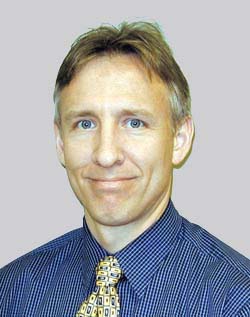
 |
Chapter Chatter |
Todd Hubing, Associate Editor |
Everything was going pretty well. I was on my way to the 2000 IEEE EMC Symposium in Washington, D.C. Although my students and others from Rolla had rented a van to make the trip, I had to be there a couple of days early, so I was flying. The weather was good, the food on the plane was good, and there was plenty of room to spread out the papers I had brought along to grade. Suddenly, a large hole opened in the floor of the aircraft and I was sucked out of the plane and found myself falling through the cold thin air toward the ground 30,000 feet below.
At first, I was in shock. What had just happened? Although I was freezing and couldn't breathe, I managed to turn and look back up at the plane. Despite a hole in its belly, the plane continued on its way. There were papers everywhere and I couldn't help but think about how disappointed my students would be when they learned that the papers they had invested several hours in were scattered across a hillside somewhere in Virginia. After reflecting on this for a second or two, another ominous thought came to mind. I too, was about to be scattered across a hillside somewhere in Virginia.
I managed to turn myself around so that I could view the landscape below. It was mostly hills and trees. I didn't see anyplace that looked like a good landing spot for a 160-pound man plummeting toward earth at 200 miles per hour.
Then, in the distance, I saw a small lake. Given the limited options available, it seemed like a good idea to try to land in the lake. (It's hard to think clearly when you're 2 miles above ground and closing rapidly.)
I spread my arms and bent my knees so that my body roughly approximated the shape of a glider. In this manner, I was able to steer myself in the general direction of the lake. I was still falling fast, but at least now, I had an objective.
As I got nearer to impact, I was able to see things a little more clearly and I became aware of two horrifying facts. First, the lake I had chosen was not a lake at all, but rather a giant mirror lying on a cement parking lot. Bad news? You bet. But what I saw in the mirror was even more frightening. I HAD A HAIRCUT JUST LIKE DON HEIRMAN'S!
I awoke in a cold sweat and ran my fingers through my hair. It was just a dream. What a relief. I guess I should have realized I was dreaming when the airline food tasted good.
How strange! That was my third Don Heirman haircut dream in as many weeks. I have to confess that I'm a little nervous about the possibility that 10 thousand dollars will be donated to the President's Memorial Award fund prior to the Washington symposium. So far, less than one-tenth of that has been raised, but who can say what might happen in the remaining time before the fourth week in August? After all, the President's Memorial Award is a very worthy cause. Money donated to this fund helps to educate tomorrow's EMC leaders while honoring the individuals who were pioneers in this field.
I've become rather comfortable with my current haircut, so in some ways it is reassuring to know that there are very few rich EMC philanthropists. On the other hand, the President's Memorial Award is the IEEE EMC Society's most important and prestigious award. In past years, this award has supported the graduate education of many individuals who are now leaders in our field. It would be sad to see this important program disappear due to a lack of financial support.
So, although I'm very comfortable with my current hairstyle, I have to admit that I would be delighted to see one or two companies that are leaders in the EMC industry accept this challenge. It would be wonderful to see the President's Memorial Award fund exceed the 10K goal before August. In fact, for me, it would be"a dream come true."
John Clarke, chair of the Central New England chapter, reports that Marc DeKirmandjian was their featured speaker at the February meeting. Marc is a Senior Applications/Product Engineer at TDK Corporation in Mount Prospect, Illinois. His talk was titled "Ferrite Electrical Characterization and Applications for EMI Control." Marc discussed the effects of temperature and current on the performance of ferrites in a circuit. He also described the different packages available for application to various types of circuits, including desktop and notebook PC video, USB and IEEE 1394. Attenuation and impedance characteristics of different types of materials and component configurations were also discussed.
The Israel IEEE EMC Society chapter's first meeting of the year and the millennium was a workshop. The workshop was held on January 27, 2000. The motto of the workshop was "A New Millennium – but Old EMC Problems," and it was dedicated primarily to the very important issue of grounding, from circuits to systems. The workshop took place at the Holon Academic Tech-nological Institute, and was hosted by Professor Jacob Gavan, a member of the chapter and a Fellow of the IEEE EMC Society.
In spite of a severe storm, participation was overwhelming at just under 100 participants. Approximately half the participants were IEEE members, and the others were guests (some of whom requested application forms to join the IEEE).
Nine presentations were given:
A special occasion was celebrated in conjunction with the meeting: The dedication of the new anechoic chamber for EMC research purposes at the Institute. The ceremony included "cutting the tape" by Professor Gavan and Professor David Maron, President of the Institute. In addition, special greetings were brought by Chapter Chair, Elya B. Joffe, who stressed the importance of the study of EMC in academia (The Institute is the first academic institute in Israel to have an EMC course and an EMC test facility for research and study purposes). The entire event was a great success.
Mr. Moshe Netzer, Israel Chapter Vice-Chairman, reports that on February 21 the first conference on "Avoidance of Explosive Atmosphere and Control of Static Charges for Preclusion of Hazards" took place in Israel, in the auditorium of the Faculty of Chemical Engineering, in the Technion, Haifa.
ESD events generated by man, equipment and machines can act as an ignition source for hazardous materials. There are several documented cases of explosions that were almost certainly due to ESD. In some cases, people were severely wounded and even killed due to such unfortunate events. In one case, a worker was killed due to an explosion in a grain silo that was apparently due to an electrostatic discharge. It appears that static charges accumulated on the seeds processed in the facility, and the resulting discharge through the air ignited the agricultural dust atmosphere causing the explosion.
This accident and others prompted the organization of the Conference, which was co-sponsored by the Israel IEEE EMC Chapter. The topics covered included issues that were of general interest to people dealing with safety and fire avoidance. The keynote address was presented by Mr. Pieter Zeeuwen, from Chilworth Technology in the UK, and was entitled: "Prevention of Explosions, with particular attention to electrostatic ignition sources." Additional presentations included:
150 participants, from all industry fields in Israel, attended this special event. The large number of attendees led to a decision to hold future such conferences in Israel. The Second Conference is planned for the First Quarter of April 2001.
The January meeting of the Nanjing chapter featured two presentations. The first presentation titled "MMIC Technology: Basic Concepts and Applications" was presented by Dr. Kwok-keung Michael Cheng of the Chinese University of Hong Kong. The second presentation was titled "An Efficient Frequency Domain Systematic approach to Model Extraction for Passive Microwave Circuits" by Dr. Ke-Li Wu. Dr. Wu is also from the Chinese University of Hong Kong. A total of 35 members and guests were in attendance.
On March 2nd, the Nanjing chapter sponsored a Workshop on Microstrip Antenna Theory and Technology featuring distinguished speakers from the Nanjing University of Science and Technology and the Nanjing Research Institute of Electronic Technology. A chapter meeting on March 10 featured Professor Yong-Ze Su, who spoke on the "RCS Calculation of Complicated Targets" and Associate Professor Chang-Qing Gu, who gave a presentation on "Iterative Physical Optics for RCS Analysis." Both speakers were from the Nanjing University of Aeronautics and Astronomy.
A meeting on March 24 featured Mo-Lin Gu of the Nanjing Research Institute of Electronic Technology, who spoke about "MIC Technology – Review and Prospects." 53 members and guests attended this presentation. Three days later, 42 members and guests were on hand for a "Technical Visit and Discussion on Microwave Power Application Technology" by Wei Chen and Cheng Mei from Sanlu Microwave Technology Company.
Randall Flinders, chair of the Orange County chapter, reports that Mark Montrose was the featured speaker at the February meeting. Mark gave a great presentation on "Fundamental Concepts and PCB Design Techniques." The topic was very well received by the audience of over 20 people. The group enjoyed Mark's frank, tell it like it is style, and also got the chance to listen to well known guru Mike King get up and assist Mark in his presentation. Dining on Lasagna, Fettuccini, and Caesar salad, it's hard to say if the attendees came for the presentation or the food!
The January meeting at the National Institute for Standards and Technology (NIST) in Boulder, Colorado had another strong turnout with 42 members and guests attending to participate in elections and enjoy the doubleheader technical program following pizza courtesy of EMC Integrity.
The following chapter officers were elected for a second term: Chairman - Lyle Luttrell, Vice Chairman - Charles Grasso, Secretary - Bob Reinert, Treasurer - John Stadille.
Barry Wallen presented "An Overview of C63 Standards." Barry currently sits on three of the C63 subcommittees and has been involved with C63 activities for the last 8 years. Barry's discussion covered a brief review of the structure of the C63 committee and its subcommittees as well as a look at their current activities. There was something here for everyone; including manufacturers, testing organizations, and designers. Barry also went into some detail about antenna calibration, alternate site calibration (no grandfather clause!) and test issues being addressed by the ANSI committee. One particular item is a proposal for conducted measurements on cables - currently in CISPR 22 3rd Edition and being examined closely by ITI TC5. This new requirement will dramatically increase test time and potentially add more cost to ITE equipment. These sorts of additions to standards exemplify why companies should participate in the standards making process.
TJ (Bill) Ritenour, of EMC Compliance LLC, closed off the meeting with "Where the Noise Starts - a Discussion on PWB Design," an excellent presentation on printed wiring board design as it pertains to EMC. The topics covered were board and board/cable resonances, ground plane inductance, the noisemakers, and finally mitigation techniques. Bill started the presentation rather differently, first with a list of references and then with a summary of old EMC theories as they pertained to board design. He covered switching transients, showed how the radiation from a printed wiring board changes with respect to its width, and compared the measured results with predicted results from a loop formula. Using some excellent hand-drawn pictures, Bill then described the concept of board and cable resonances as well as connector ground bounce. We were then presented with the four sources of common-mode current: IC switching induced CM current, capacitor decoupling induced CM current, transmission line induced CM current and connector induced CM current. Bill then covered decoupling capacitors discussing chip cross over current, rise time, capacitor lead inductance, parasitic resonance, series resonance and dynamic impedance. Finally, Bill detailed some printed wiring board practices that can cause EMI and presented mitigation techniques. All in all, it was a very well received presentation - Thanks Bill! You can download the presentation at https://www.ewh.ieee.org/r5/denver/rockymountainemc/.
On February 26 the Rocky Mountain Chapter joined other Technical Society Chapters in the Denver Section as part of the IEEE Denver Expo 2000 – a Professional Activities Conference in the Denver Tech Center. The Saturday conference had a total attendance of some 150 people, with over 25 attending the EMC session and receiving a CD-ROM including the presentation notes. The Chapter thanks Auspex Systems for enabling Doug Smith to speak at our meeting and Agilent Technologies for providing the measurement equipment used in Doug's demonstrations. Doug Smith presented "An Overview of High Frequency Measurement Techniques for Design Verification and Trouble-shooting." Doug provided an in-depth study of signal and noise measuring techniques for characterizing and troubleshooting electronic circuits and designs in the frequency range of 20 MHz to 1 GHz and higher. As a bonus, he also covered techniques for finding and fixing signal integrity, noise and EMC problems.
Doug started the talk with an interesting demonstration using a homemade 50MHz oscillator driving a "Black Box". Doug attached a calibrated scope probe to each of the two outputs of the box. He then demonstrated that the outputs of the boxes were not identical. Not terribly strange – until he opened the box to reveal that the two outputs were actually attached together. The question he started the day with was – Why?
The talk started with an overview of basic theory on inductance, magnetic coupling, shielded cables and skin effect with an emphasis on measurement tools such as scope probes and differential measurement techniques. Doug then proceeded to show some examples of clock waveforms that were less than perfect and proved conclusively that there is a direct relationship between the cost of the measurement equipment and confidence in the result. We then covered a section on scope probe characteristics of various probe designs including Doug's favorite – the balanced coaxial probe. Using simple math and graphical displays, Doug showed how scope probes – even the expensive low capacitance ones – can dramatically change in characteristic as the frequency increases.
In the next section, Doug covered induced voltages and their effect on measurements. He reviewed basic theory on inductance, mutual inductance and shielded cable operation. Doug walked us through some simple concepts on mutual inductance and introduced the idea that a coaxial cable is really a 1:1 transformer between the shield and the center conductor. He also demonstrated that, by using inductance and mutual inductance as constants, one could design a probe that will give a qualitative analysis of the noise in a circuit in question. In this case the probe was square – a bent paper clip and a piece of 50-ohm coaxial cable. Doug also presented another method of visualizing a shielded cable, such as a coax cable in that a shielded cable often works by inducing noise on the center conductor rather than keeping noise out. Doug then introduced us to the "NULL" experiment, which amounts to validating the measurement.
The third section covered differential measurements. Doug first covered all the techniques that are used and reviewed some of the more common mistakes that can occur in such measurements. After looking at all other methods, Doug then went into some detail on the Balanced Coaxial Probe. He showed, using some ESD-induced waveforms, how the balanced coaxial probe was more immune to induced noise as it has a highly balanced common-mode rejection ratio.
The final section dealt with non-contact measurements. In this section, Doug covered exactly how the square loop worked and reviewed some of the more interesting aspects of the more ubiquitous round loops that we are all familiar with.
During the talk Doug punctuated his points with demonstrations and experiments. Overall, the presentation was well received and appreciated by all. Thank you, Doug. For more information on Doug, you can go to his website: www.dsmith.org.
Dave Bernardin, chair of the San Diego chapter, reports that they had a terrific meeting on March 15 featuring Mr. Doug Smith. The subject of Mr. Smith's talk was EFT Testing Per IEC 61000-4-4. The audience participation was great and the presentation included a practical demonstration using an EFT generator, a small length of hook up wire and an Agilent Technologies Infinium oscilloscope. At the end of the lecture, Doug Smith handed everyone CDÕs whichcontained articles, papers and information from his web site at https://www.dsmith.org.
The San Diego chapter would like to thank Mr. David Badtorff, Field Engineer from Agilent Technologies, for the loan of the $30,000, four channel, 1.5 GHz, Infinium oscilloscope and his personal time.
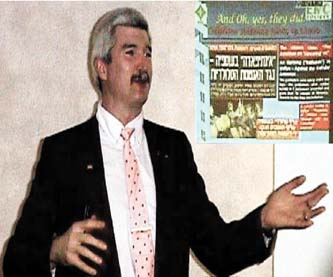 |
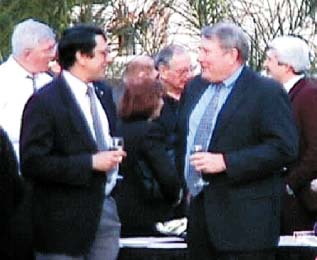 |
EMC Society Distinguished Lecturer Elya Joffe points out some of the scary headlines in Israeli newspapers concerning elctromagnetic fields. |
Consultant Mark Montrose (L) and newly elected EMC Society President, Joe Butler, enjoy the social time before the buffet dinner in Phoenix. |
Harry Gaul, secretary/treasurer of the Phoenix chapter, reports that their last meeting was held on March 23. This meeting was a regular "Who's Who in the EMC World" as it was held in conjunction with the EMC Society's Board of Directors meeting in Phoenix. Attendees included the new president of the EMC Society, Joe Butler, as well as the outgoing president, Dan Hoolihan. Also on hand were Dr. Todd Hubing, Mark Montrose, Doug Smith, Henry Benitez, Ghery Pettit, Janet O'Neil, Don Heirman and many other EMC "celebrities".
Some 60 attendees enjoyed a lavish Mexican dinner buffet followed by an enlightening talk by EMC Society Board of Directors member and EMC Society Distinguished Lecturer, Elya Joffe. The presentation was titled "Why Are People Really Scared of EM Fields - ElectroPhobia". In this talk, Elya outlined the reasons why we are scared of EM fields. In particular, the general public gets their impressions from the media and scary headlines sell. The fact of the matter is that most studies conclude that there are no health problems, but the researchers always say that more studies are needed. Of course, they do this so that they can obtain more funding and stay gainfully employed. The sad part of this situation is that funding is diverted and researchers are distracted from finding the real cause of cancer. An exhaustive study and report was recently completed by the National Institute of Environmental Health Sciences. The study concluded, based on the evidence to date, that ELF and EMF exposure should not be included in a list of carcinogens.
Elya also shared with us some recent news from his homeland in Israel where a riot occurred in the village of Usfiya because of a protest over the location of a cell phone tower. This riot on March 15 resulted in 18 people suffering injuries. Although many, many people use cell phones in Israel, it is becoming increasingly difficult to get permits to locate cell phone towers. Of course, one could resort to hiding the antenna towers but then the activists would say that must indicate that we've got something to hide about the dangers of electromagnetic fields. As responsible scientists and engineers, we need to help dispel the rumors and scientific untruths concerning the safety of electromagnetic fields.
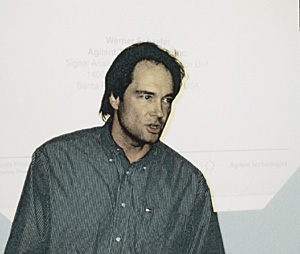 |
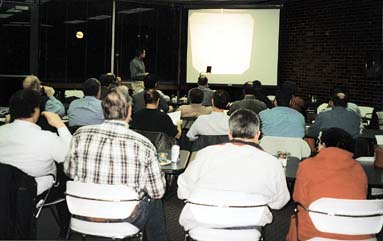 |
Speaker Werner Schaefer drives home the point during his presentation to the Oregon and SW Washington EMC Chapter meeting in February. |
There was a great turn out by chapter members to hear Werner Schaefer at the Tektronix facility in Beaverton. Some 40 people attended the meeting of the Oregon and SW Washington EMC Chapter. |
Chairman Henry Benitez reports that the chapter has continued its goal to provide IEEE activities each month. Michael J. Windler, Underwriters Laboratories, was our January distinguished speaker. Mr. Windler gave an excellent account of updates to the ANSI ASC C63 Subcommittee 1 site attenuation standard. He presided over a riveting discussion pertaining to site calibration, antenna calibration and the viability of alternate test sites. Mr. Werner Schaefer of Agilent Technologies was our February distinguished speaker. He gave a well-attended audience an outstanding presentation on "Understanding Impulse Bandwidth Specifications of EMI Receivers". Mr. Pat Andre of CKC Laboratories provided a presentation called "EMC Follies and Foibles" in March. Once again we had excellent attendance. We know it was due to the subject matter and not the complimentary Buster's Barbecue! Mr. Andre had 10 EMC stories about EMC issues and their solutions. At the end of the presentation, we opened it up for "EMI War Story" contributions from the membership at large. Several excellent impromptu contributions were given. (Note: An "EMC War Stories" Session will be introduced at the Washington, DC EMC Symposium in August. It should be a great success if this meeting was any indication!)
We are looking forward to upcoming meetings this spring that include Maqsood Mohd on Lightning Effects and Doug Smith presenting an RF Probe Building Workshop. A summer social and contribution to the local IEEE Section Summer Social is anticipated as well.
 |
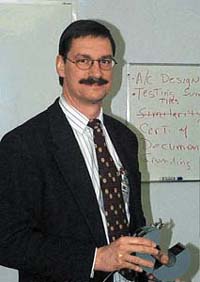 |
During his visit to the Seattle EMC Chapter in January, speaker Mike Windler of UL(R) took some time to visit the Kalmus facility in neighboring Bothell. Leo Smale of Kalmus was pleased to take Mike on a tour of the manufacturing area. |
Pat Andre of CKC Labs presented the lively and entertaining "EMC Follies and Foibles" at the March EMC Chapter meeting in Seattle. |
Vice-Chairman Janet O'Neil reports that the chapter started the new-year with a spirited presentation by Michael J. Windler of Underwriters Laboratories in Northbrook, Illinois. The presentation was entitled "Improvements to C63.4 Normalized Site Attenuation." This topic drew representatives from several EMC test labs in the area including CKC Labs, Acme Testing, and Northwest EMC. Mr. Windler presented an update on the new antenna calibration standard activities within the American National Standards Institute (ANSI) Accredited Standards Committee (ASC) C63 Sub-committee 1 (on EMC). Mr. Windler is an active member of ANSI-ASC C63 including Subcommittee 1 on Techniques and Developments and Sub-committee 6 on Laboratory Accreditation/Lab Assessment. An exciting discussion took place concerning different calibration methods, different test distances and usage in different types of test facilities. Mr. Windler provided extensive data to demonstrate results of experimentation. The data used will have immediate impact on future revisions to ANSI C63.5 as well as ANSI C63.4.
Mike Windler is the Associate Managing Engineer for International EMC Services with Underwriters Laboratories in Northbrook, Illinois. Having been the manager of UL's Northbrook EMC lab for four years, he had much in common with several chapter members present from the various local test labs.
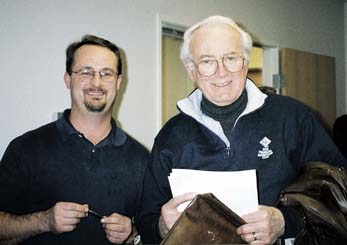 |
Paul Slavens of Acme Testing (L) paused to speak with Len Carlson, EMCS Vice-President for Communications, at the January EMC Chapter meeting in Seattle. Paul drove 80 miles one way to hear the presentation by Mike Windler! |
In February, Werner Schaefer of Agilent Technologies (formerly Hewlett-Packard), in Santa Rosa, California visited the chapter. Mr. Schaefer is an IEEE EMC Society Distinguished Lecturer (DL). This was his first presentation under the DL program and the chapter was not disappointed! His topic was "Under-standing Impulse Bandwidth Specifications of EMI Receivers" which was presented in a lively and very interactive way with the audience. Mr. Schaefer advised that when measuring emissions with an EMI receiver or spectrum analyzer, different signal types might be encountered. Their classification as narrowband or broadband is dependent upon the signal's spectral distribution relative to the receiver's resolution bandwidth used for the measurement. It is essential to know which type of signal is being measured to avoid erroneous test results and the wrong
interpretation of data. In this context, the knowledge of the instrument's impulse bandwidth is necessary to correctly determine the absolute amplitude value of an emission. The determination of the receiver's impulse bandwidth can be done with a series of measurements, but not simply by multiplication of its 3dB or 6dB bandwidth value with a constant factor. Only the accurate knowledge of this parameter allows a meaningful comparison of the measured emission levels to a limit line and verification of a product's compliance with an EMI standard.
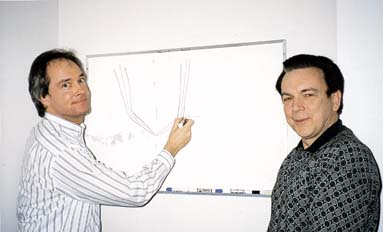 |
At the February meeting of the Seattle EMC Chapter, speaker Werner Schaefer of Agilent Technologies (L), provided an in-depth explanation of a technical point to chapter member and EMC consultant Frederick Telewski. |
The presentation covered definitions of broadband signals, the impulse bandwidth of a filter, and the effect of filtering on a broadband signal. Plus, an easy method to determine the impulse bandwidth of a receiver was described. References were also made to the current status of bandwidth definitions in national and international standards.
The chapter took a different turn with its technical presentations in March when Pat Andre, Manager and Consulting Engineer with CKC Labs, presented the lighthearted and entertaining topic "EMC Follies and Foibles." Mr. Andre shared his top 10 favorite EMC design and engineering stories, including the famous "Talking House" story. By hearing some of the more humorous EMC design errors and consulting misdiagnosis's, chapter members learned how to correct common EMC problems or better yet, avoid them altogether. No names were shared to protect the innocent! It was a unique opportunity to learn while being entertained.
Please see the Seattle Section website www.ieee-seattle.org/ for further, up-to-date information about the Seattle EMC chapter meetings. Or, contact Seattle EMC chapter Secretary Stephen Stimac via e-mail at sastimac@home.com, provide your e-mail address, and the Seattle EMC Chapter Newsletter will be e-mailed to you as a pdf file automatically prior to each meeting. If you're in the area, please join us at a chapter meeting! EMC